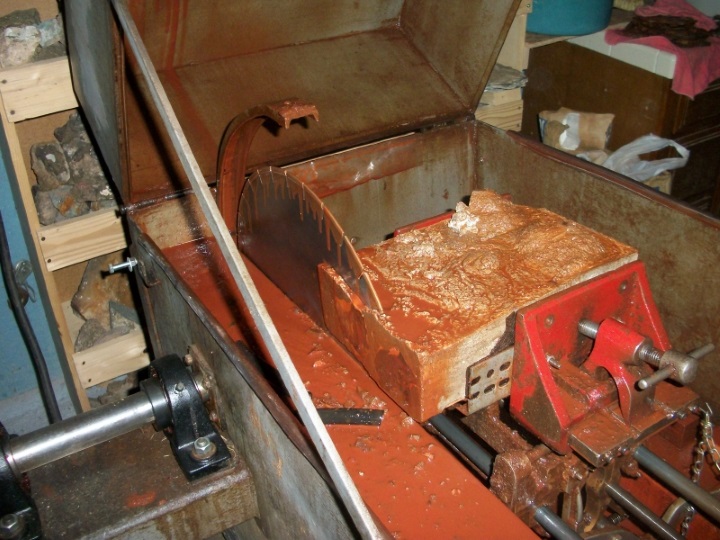|
|
Post by 1dave on Sept 28, 2019 14:12:42 GMT -5
I have used and appreciated many different rock clamps, but some rocks seem unclampable.AND if the rock slips loose while being sawed,  Goodby blade. When the clamps won't fit the rock, make the rock fit the clamp!  Make a form that fits your saw vise. Diesel Fuel is a good release agent. Brush some on the form and the rock. Place the rock in the form the way you want it cut, fill it in place with Mortar Mix. Huh! A perfect fit! |
|
|
|
Post by toiv0 on Sept 29, 2019 1:23:05 GMT -5
Pretty cool, how bad does it muck up the oil?
|
|
|
|
Post by hummingbirdstones2 on Sept 29, 2019 8:26:35 GMT -5
Local college lapidary instructor recommended using plaster of paris. He's been a professional lapidary (his only "job") for 40 years. Have never tried it yet, but most of his tips have been pretty good over the years.
|
|
|
|
Post by 1dave on Sept 29, 2019 8:39:31 GMT -5
Pretty cool, how bad does it muck up the oil? Muck? What muck?  Muck is part of the gig. hummingbirdstones2 I started with Plaster of Paris, Sand Mix is cheaper and more available. |
|
NRG
fully equipped rock polisher
  
Member since February 2018
Posts: 1,688
|
Post by NRG on Sept 29, 2019 18:00:42 GMT -5
jamesp, I believe, uses polymer grout. Same way. I'll let him chime in.
|
|
|
|
Post by Peruano on Oct 2, 2019 10:25:58 GMT -5
I' d have a problem with multiple stones in the same block. You would have minimal control over where you slabbed individual stones . I'm not a random slabber although I never know exactly what I will get. To secure a special stone I might do it but not for simultaneous multiples.
|
|
|
|
Post by 1dave on Oct 8, 2019 20:50:51 GMT -5
I' d have a problem with multiple stones in the same block. You would have minimal control over where you slabbed individual stones . I'm not a random slabber although I never know exactly what I will get. To secure a special stone I might do it but not for simultaneous multiples. It seems to me to give maximum control over how I place each rock. |
|
jamesp
Cave Dweller 
Member since October 2012
Posts: 36,612
|
Post by jamesp on Oct 20, 2019 3:56:00 GMT -5
jamesp, I believe, uses polymer grout. Same way. I'll let him chime in. Yep. Mapei brand polymer BLACK grout for thin jointed tiles from Lowes. Cast pebbles, saw after 48 hours. Best to do a short tumble afterwards to remove grout. Some 1 to 2 inch Rio gravels cast in Mapei polymer and sawn from 1st trip. Collected by the 100's at large gravel bars. A smorgasbord. Cast in wood form like Dave did. www.flickr.com/photos/67205364@N06/albums/72157663161484949Or saw slabs of crushed jasper in much harder portland cement  |
|
jamesp
Cave Dweller 
Member since October 2012
Posts: 36,612
|
Post by jamesp on Oct 20, 2019 4:07:13 GMT -5
Oh yea, warning - I used diesel mixed 25% 10w-40 motor oil. (The oil reduces potential flash point of diesel.) The concrete/grout is hard on expensive saw oil. This casting done in a 2 gallon plastic bucket. Square is better like Dave's. Sawing these castings was a real rush. Makes killer cab stock. Keep in mind when sawing round pebbles the heel can come loose and jam the saw and cook your clutch or burn your belt. Stay next to saw and ready to turn it off. un-jamb wedge and keep cutting.  |
|
|
|
Post by 1dave on Oct 20, 2019 9:02:56 GMT -5
Keep in mind when sawing round pebbles the heel can come loose and jam the saw and cook your clutch or burn your belt. Stay next to saw and ready to turn it off. un-jamb wedge and keep cutting. That is something I fortunately did not experience and should have prepared for! |
|
|
|
Post by stardiamond on Oct 20, 2019 11:57:19 GMT -5
I glue rock to a 2x4 piece with sodium silicate (water glass). I can angle the 2x4 in the vise to get the orientation I want. I just make sure the board is securely clamped in the vise. The sodium silicate soaks off in a day.
|
|